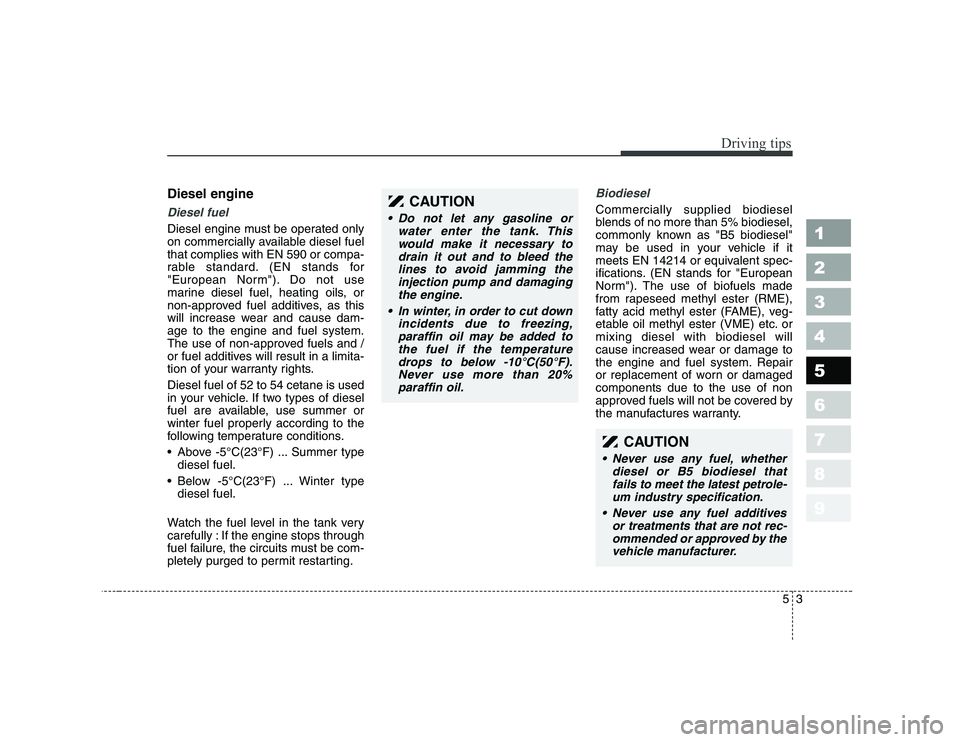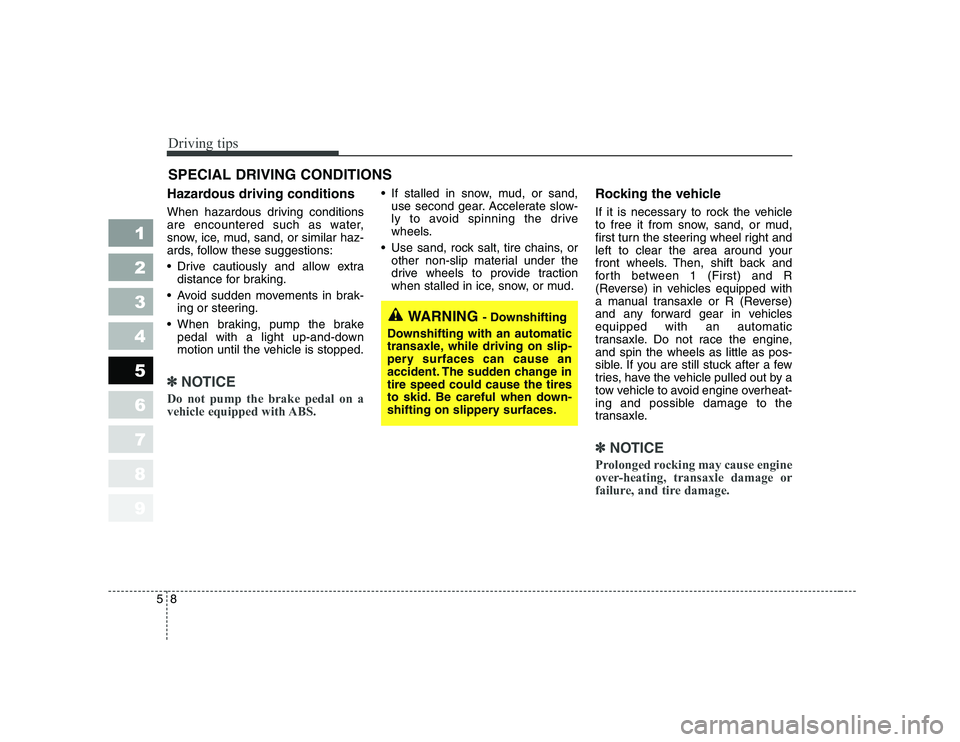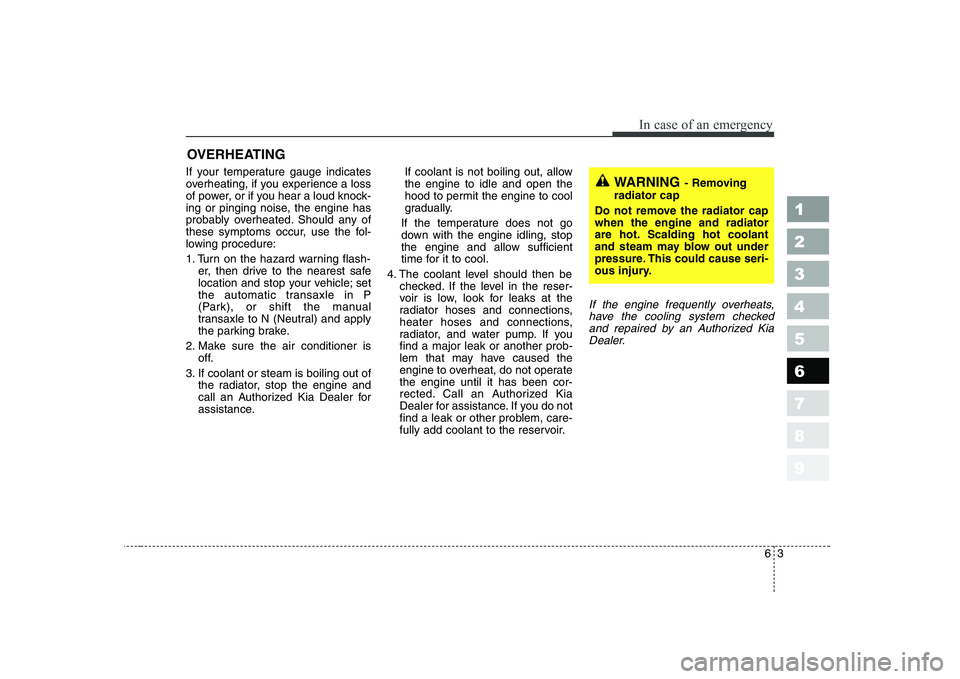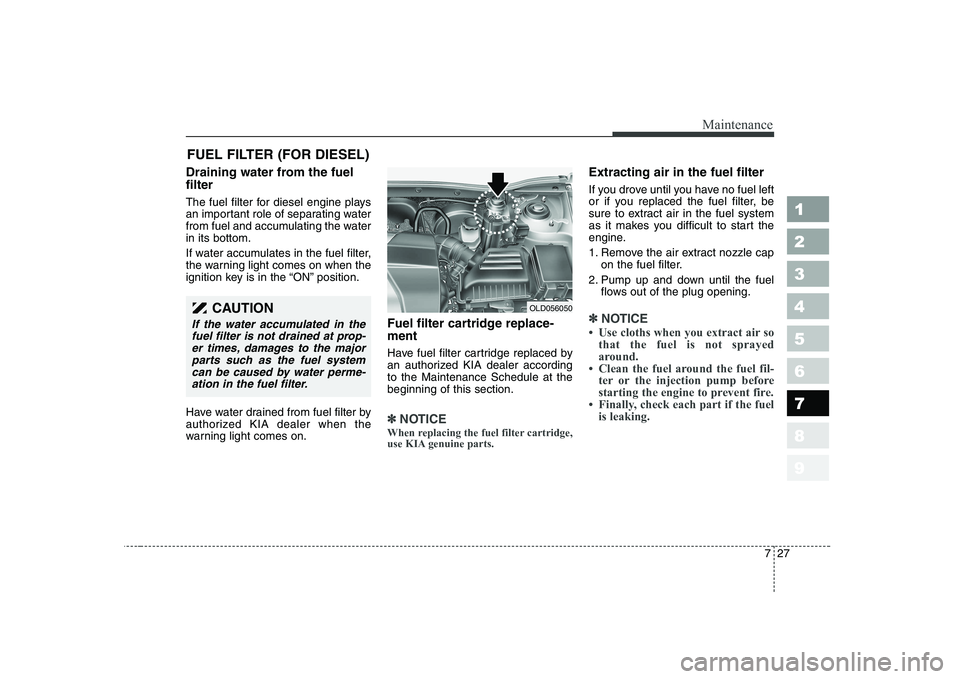2008 KIA CERATO water pump
[x] Cancel search: water pumpPage 217 of 327

53
Driving tips
Diesel engine
Diesel fuel
Diesel engine must be operated only
on commercially available diesel fuelthat complies with EN 590 or compa-
rable standard. (EN stands for
"European Norm"). Do not use
marine diesel fuel, heating oils, or
non-approved fuel additives, as this
will increase wear and cause dam-age to the engine and fuel system.
The use of non-approved fuels and /
or fuel additives will result in a limita-
tion of your warranty rights. Diesel fuel of 52 to 54 cetane is used
in your vehicle. If two types of diesel
fuel are available, use summer or
winter fuel properly according to the
following temperature conditions.
Above -5°C(23°F) ... Summer typediesel fuel.
Below -5°C(23°F) ... Winter type diesel fuel.
Watch the fuel level in the tank very
carefully : If the engine stops through
fuel failure, the circuits must be com-
pletely purged to permit restarting.
Biodiesel
Commercially supplied biodiesel
blends of no more than 5% biodiesel,
commonly known as "B5 biodiesel"
may be used in your vehicle if it
meets EN 14214 or equivalent spec-
ifications. (EN stands for "European
Norm"). The use of biofuels made
from rapeseed methyl ester (RME),
fatty acid methyl ester (FAME), veg-
etable oil methyl ester (VME) etc. ormixing diesel with biodiesel will
cause increased wear or damage to
the engine and fuel system. Repair
or replacement of worn or damagedcomponents due to the use of non
approved fuels will not be covered by
the manufactures warranty.
1 23456789
CAUTION
• Do not let any gasoline or water enter the tank. Thiswould make it necessary todrain it out and to bleed thelines to avoid jamming the injection pump and damagingthe engine.
In winter, in order to cut down incidents due to freezing,paraffin oil may be added to the fuel if the temperaturedrops to below -10°C(50°F).Never use more than 20% paraffin oil.
CAUTION
Never use any fuel, whether diesel or B5 biodiesel thatfails to meet the latest petrole-um industry specification.
Never use any fuel additives or treatments that are not rec-ommended or approved by the vehicle manufacturer.
Page 222 of 327

Driving tips
8
5
1 23456789
SPECIAL DRIVING CONDITIONS
Hazardous driving conditions
When hazardous driving conditions
are encountered such as water,
snow, ice, mud, sand, or similar haz-
ards, follow these suggestions:
Drive cautiously and allow extra distance for braking.
Avoid sudden movements in brak- ing or steering.
When braking, pump the brake pedal with a light up-and-down
motion until the vehicle is stopped.
✽✽ NOTICE
Do not pump the brake pedal on a
vehicle equipped with ABS.
If stalled in snow, mud, or sand, use second gear. Accelerate slow-
ly to avoid spinning the drive
wheels.
Use sand, rock salt, tire chains, or other non-slip material under the
drive wheels to provide traction
when stalled in ice, snow, or mud. Rocking the vehicle
If it is necessary to rock the vehicle
to free it from snow, sand, or mud,
first turn the steering wheel right and
left to clear the area around your
front wheels. Then, shift back and
forth between 1 (First) and R
(Reverse) in vehicles equipped with
a manual transaxle or R (Reverse)
and any forward gear in vehiclesequipped with an automatic
transaxle. Do not race the engine,and spin the wheels as little as pos-
sible. If you are still stuck after a few
tries, have the vehicle pulled out by a
tow vehicle to avoid engine overheat-
ing and possible damage to the
transaxle.
✽✽
NOTICE
Prolonged rocking may cause engine
over-heating, transaxle damage or
failure, and tire damage.
WARNING - Downshifting
Downshifting with an automatic
transaxle, while driving on slip-
pery surfaces can cause an
accident. The sudden change intire speed could cause the tires
to skid. Be careful when down-
shifting on slippery surfaces.
Page 240 of 327

63
In case of an emergency
OVERHEATING
If your temperature gauge indicates
overheating, if you experience a loss
of power, or if you hear a loud knock-
ing or pinging noise, the engine has
probably overheated. Should any of
these symptoms occur, use the fol-
lowing procedure:
1. Turn on the hazard warning flash- er, then drive to the nearest safe
location and stop your vehicle; set
the automatic transaxle in P
(Park), or shift the manual
transaxle to N (Neutral) and apply
the parking brake.
2. Make sure the air conditioner is off.
3. If coolant or steam is boiling out of the radiator, stop the engine and
call an Authorized Kia Dealer for
assistance. If coolant is not boiling out, allowthe engine to idle and open the
hood to permit the engine to cool
gradually.
If the temperature does not go
down with the engine idling, stop
the engine and allow sufficient
time for it to cool.
4. The coolant level should then be checked. If the level in the reser-
voir is low, look for leaks at the
radiator hoses and connections,
heater hoses and connections,
radiator, and water pump. If youfind a major leak or another prob-
lem that may have caused the
engine to overheat, do not operatethe engine until it has been cor-
rected. Call an Authorized Kia
Dealer for assistance. If you do not
find a leak or other problem, care-
fully add coolant to the reservoir.
If the engine frequently overheats,
have the cooling system checkedand repaired by an Authorized Kia Dealer.
1 23456789
WARNING - Removing
radiator cap
Do not remove the radiator cap when the engine and radiator
are hot. Scalding hot coolant
and steam may blow out under
pressure. This could cause seri-
ous injury.
Page 268 of 327

1 23456789
75
Maintenance
NORMAL MAINTENANCE SCHEDULE
I : Inspect and if necessary, adjust, correct, clean or replace.
R : Replace or change. *1: Adjust alternator and power steering (and water pump drive belt) and air conditioner drive belt (if equipped).
Inspect and if necessary correct or replace.
*2 : Check the engine oil level and leak every 500 km (350 miles) or before starting a long trip.
*3 : For your convenience, it can be replaced prior to it's interval when you do maintenance of other items.
MAINTENANCE
INTERVALS
MAINTENANCE ITEMNumber of months or driving distance, whichever comes first
Months 12 24 36 48 60 72 84 96
Miles×1,000 10 20 30 40 50 60 70 80
Km×1,000 15 30 45 60 75 90 105 120
Drive belts *1 Gasoline I I I I I I I I
Diesel I I I I
Engine oil and Gasoline R R R R R R R R
engine oil filter *2
Diesel For Europe R R R R R R R R
Except Europe
Gasoline (2.0L)Engine timing belt
Tensioner/idler Gasoline (2.0L)
Air cleaner filter
I I R I I R I I
Air cleaner filter For Middle East
Spark plugs (Gasoline)
Replace every 10,000 km (6,000 miles) or 12 months
Inspect every 90,000 km (60,000 miles) or 48 months
and replace every 140,000 km (90,000 miles) or 72 months*3
Replace every 40,000 km (25,000 miles) *3
Replace every 15,000 km (10,000 miles)
Inspect when timing belt is inspected or replaced
Page 269 of 327

1 23456789
Maintenance
6
7
NORMAL MAINTENANCE SCHEDULE (cont.)
MAINTENANCE
INTERVALS
MAINTENANCE ITEMNumber of months or driving distance, whichever comes first
Months 12 24 36 48 60 72 84 96
Miles×1,000 10 20 30 40 50 60 70 80
Km×1,000 15 30 45 60 75 90 105 120
Valve clearance *4
Gasoline
Vapor hose and fuel filler cap
I I I I
Fuel tank air filter (if equipped) I I R I I R I I
Vacuum and crankcase ventilation hosesGasolineIIII
Vacuum hose (for VGT) (if equipped) Diesel
III IIIII
Vacuum pump and vacuum hose DieselIII IIIII
Vacuum pump oil hose DieselIII IIIII
Fuel filterGasoline RR
Fuel filter cartridge *6
Diesel R R R R
Fuel lines, hoses and connections I I I I I I I I Cooling system
Inspect every 96,000 km (60,000 miles) or 48 months *5
Inspect “Coolant level and leak” every day
Inspect “Water pump” when replacing the drive belt or timing belt
I : Inspect and if necessary, adjust, correct, clean or replace. R : Replace or change. *4 : Inspect for excessive valve noise and/or engine vibration and adjust if necessary. A qualified technician should
perform the operation.
*5 : For your convenience, it can be replaced prior to it's interval when you do maintenance of other items.
*6 : If the diesel fuel specifications don't meet the European standards EN590, replace it more frequently.
Consult an authorized KIA dealer for details.
Page 290 of 327

727
Maintenance
1 23456789
FUEL FILTER (FOR DIESEL)
Draining water from the fuel filter
The fuel filter for diesel engine plays
an important role of separating water
from fuel and accumulating the waterin its bottom.
If water accumulates in the fuel filter,
the warning light comes on when the
ignition key is in the “ON” position.
Have water drained from fuel filter by
authorized KIA dealer when the
warning light comes on. Fuel filter cartridge replace- ment
Have fuel filter cartridge replaced by
an authorized KIA dealer accordingto the Maintenance Schedule at thebeginning of this section.
✽✽
NOTICE
When replacing the fuel filter cartridge,
use KIA genuine parts.
Extracting air in the fuel filter
If you drove until you have no fuel left
or if you replaced the fuel filter, be
sure to extract air in the fuel system
as it makes you difficult to start the
engine.
1. Remove the air extract nozzle cap on the fuel filter.
2. Pump up and down until the fuel flows out of the plug opening.
✽✽NOTICE